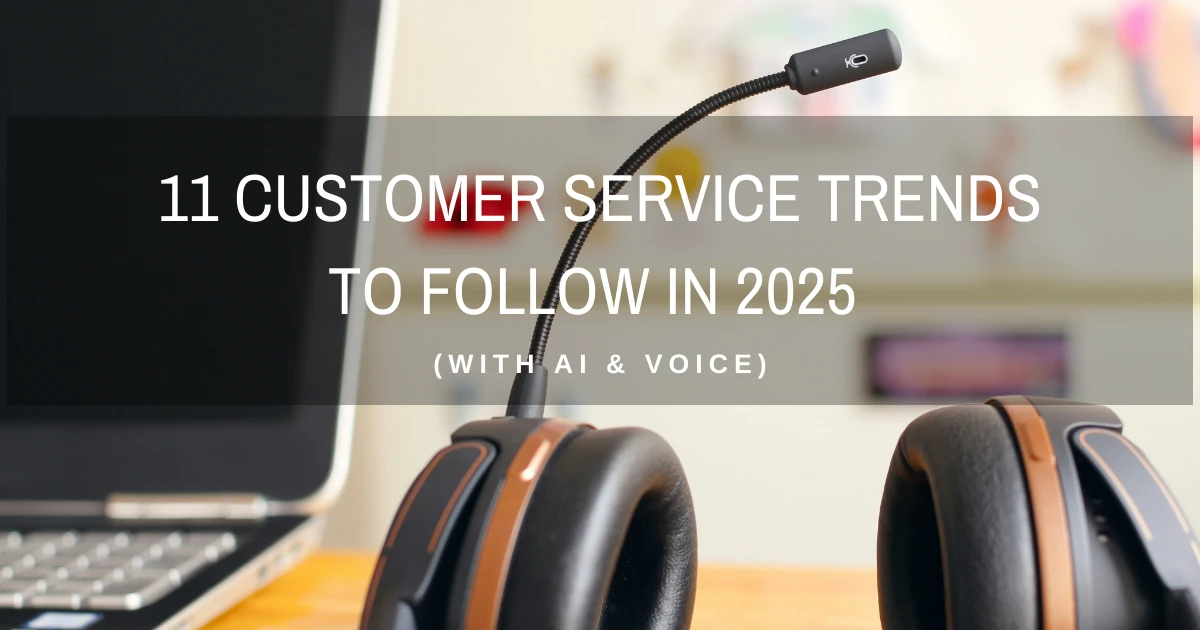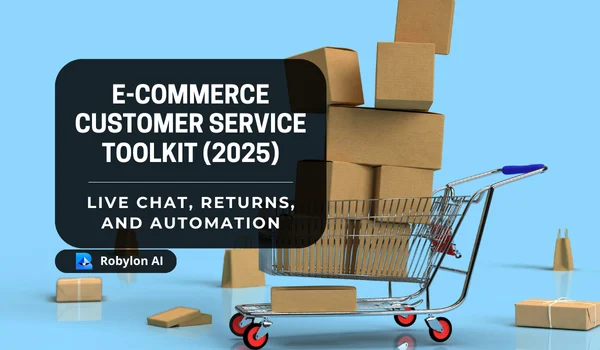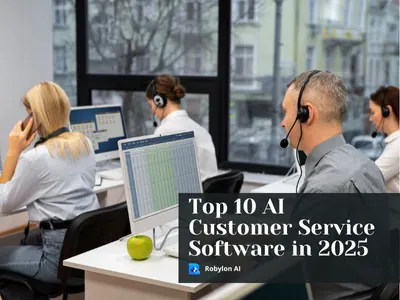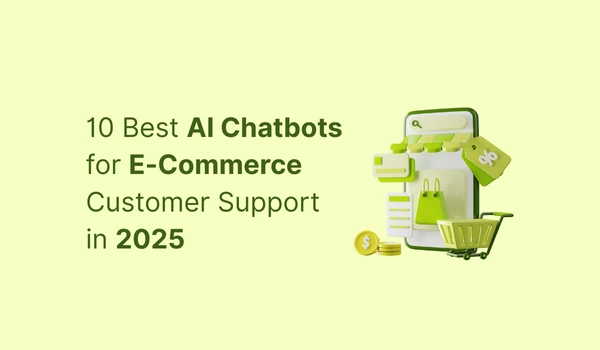TLDR
The future of customer service in 2025 is AI-first, human-backed, and results-driven. These trends are not just predictions; they are actionable shifts you can implement now.
- From Copilot to Autonomy - AI evolves from assisting agents to autonomous customer service, resolving entire conversations without human help.
- Voice AI at the Core - Conversational Voice AI replaces outdated IVRs, improves containment, and reduces costs.
- True Omnichannel - A unified data layer ensures seamless handoffs and consistent tone across WhatsApp, email, chat, and voice.
- Proactive with Predictive AI - Anticipate issues using VOC + operational data, intervening before customers reach out.
- Smarter Self-Service - AI-powered search and dynamic KBs boost self-service success and digital deflection.
- Real-Time Sentiment + AI QA - Live emotion detection and automated QA enable faster saves and 100% interaction review.
- AI-Driven WFM - Intelligent forecasting aligns agent skills to predicted queries, reducing AHT and improving FCR.
- Hyper-Personalization - CDP and GenAI tailor interactions in real-time while maintaining privacy compliance.
- GenAI as the CX Engine - Powers content creation, proactive outreach, and context-aware responses at scale.
- Human + AI Partnership - AI handles speed and scale; humans own trust, empathy, and complex decisions.
- Multimodal AI - AI interprets text, voice, images, and video together for faster, more accurate resolutions.
Introduction: The AI Trends Shaping Customer Experience in 2025
AI in customer service 2025 is no longer experimental; it is operational, measurable, and delivering results at scale. Support is changing from reactive ticket handling to predictive, outcome-driven experiences. For instance, agents assist copilots that guide every keystroke and provide fully autonomous customer assistance powered by agentic AI.
Voice AI customer service is replacing old IVR menus with conversations that sound like they were made by real people at contact centers. GenAI is making it possible to send hyper-personalized responses, analyze consumer sentiment in real time, and reach out to customers before they even ask for help. What once took minutes or required multiple agents can now be resolved in seconds with higher accuracy and lower cost.
This transformation isn’t just about speed. It’s about CSAT improvement, higher first contact resolution (FCR), and reduced average handle time (AHT) , the KPIs that define service excellence. Forward-thinking teams are combining automation, omnichannel orchestration, and responsible AI guardrails to develop efficient, compassionate, and revenue-generating services.
In this article, we will cover 11 actionable, data-backed customer service trends that you can implement today. Each trend includes practical next steps, no hype, no theory so you can ship improvements next week, not next quarter. Whether you are scaling self-service, deploying voice AI, or moving from copilots to fully autonomous agents, these strategies will help you stay ahead in the future of customer service.
Ready to bring AI-powered customer service to your business or adopt these 2025 trends? Book a demo today.
Customer Experience Trends 2025 | From Copilots to Autonomous Service
Trend 1 - From Agent Assist Copilot to Autonomous CS

The future of customer service is shifting from AI copilots that assist agents to autonomous customer service, where agentic AI resolves entire conversations without human intervention. In 2023-2024, most AI deployments focused on copilots' real-time assistants embedded in agent desktops that suggested responses, summarized chats, or retrieved relevant knowledge base articles.
In 2025, leading CX teams are upgrading these copilots into autonomous agents that can manage end-to-end resolutions for repetitive, high-volume queries without escalation.
The technology shift is powered by retrieval-augmented generation (RAG) for accuracy, LLM fine-tuning for brand tone, and guardrails to ensure compliance. The impact is measurable
- First Contact Resolution (FCR) rates climb as common issues are resolved instantly.
- Deflection rate improves as fewer queries require live agent intervention.
- Average Handle Time (AHT) drops significantly, improving team productivity and reducing operational costs.
How to Deploy?
- Quick setup: Identify your top 3 repeat queries (e.g., order status, password reset, subscription changes) and train an autonomous agent for them.
- Process: Define confidence thresholds for AI responses and set escalation rules when confidence falls below safe limits.
- KPI: Track autonomy rate (percentage of tickets resolved without human help) and compare post-automation AHT to baseline.
To understand the mechanics behind this shift from copilots to autonomous AI agents, explore How AI Chatbots Work.
Trend 2 - Voice AI Becomes a Core Channel

Voice AI customer service has moved from a niche experiment to an essential pillar of customer service. With the rise of generative AI and natural language understanding (NLU), modern conversational AI can handle voice interactions dynamically, adapting responses based on intent, emotional tone, and past interactions.
In contact centers, this transformation starts by replacing outdated IVR menus with AI-driven IVR, which listens, understands, and responds naturally. Frustrated callers get routed directly to agents, while routine queries stay within AI flows for faster service.
Key capabilities
- Call summarization to instantly update CRM records.
- Real-time sentiment analysis to adjust tone or escalate sensitive calls.
- Proactive outbound voice for reminders, renewals, and alerts.
The business impact is clear: higher containment rates, lower average handle time (AHT), and improved sentiment shift scores. Contact centers deploying conversational Voice AI have reported a 23.5% reduction in cost per contact and a 4% increase in annual revenue.
Deploy Now
- Quick Setup: Pilot AI-powered IVR for one high-volume inbound category (e.g., order tracking).
- Process: Implement sentiment-based routing rules to prioritize at-risk customers.
- KPI: Track containment rate, post-call AHT, and sentiment shift for calls handled by AI vs. human agents.
To explore this trend in depth, you can refer directly to The Ultimate Guide to AI Voice Agents in 2025 for a comprehensive overview.
Trend 3 - Omnichannel Customer Support with a Unified Data Layer

The difference between multichannel and omnichannel customer support is integration. Multichannel offers multiple touchpoints (WhatsApp, chat, email, voice) but in silos; omnichannel stitches them into a single, connected journey.
In 2025, the foundation of true omnichannel is a Customer Data Platform (CDP). By creating unified customer profiles, a CDP consolidates every message, call, and chat from WhatsApp support to email threads and voice transcripts into a single customer timeline.
Outcomes include
- Seamless handoffs between channels without customers repeating themselves.
- Consistent tone and context across all channels.
- Faster resolutions through complete historical context.
With 71% of consumers expecting consistency across channels but only 29% receiving it, omnichannel isn’t just a feature, it’s a competitive differentiator. A unified data layer enables faster resolution, reduces frustration, and builds trust over time.
Deploy Now
- Quick setup: Audit your top three customer channels for context gaps during handoffs.
- Process: Connect these channels to a single customer timeline via your CRM or CDP.
- KPI: Measure handoff success rate, CSAT post-handoff, and average resolution time across channels.
Tools like Robylon integrate with 40+ CRMs, helpdesks, and e-commerce tools to power true omnichannel support with a unified data layer. Explore Now
Trend 4 - Proactive Customer Support by Predictive AI
In 2025, proactive customer support is moving from a competitive advantage to a baseline expectation. By combining Voice of the Customer (VOC) data with operational metrics from systems like CRM, ERP, and product analytics, support teams can predict issues, intervene early, and tailor outreach before customers even reach out.
Predictive AI identifies warning signs such as declining feature usage, frequent error logs, or sentiment dips and triggers the right action.
- Sending alerts before product failures.
- Offering loyalty incentives before churn risk peaks.
- Delivering training or resources to struggling users during onboarding.
Microsoft’s research shows 67% of customers respond favorably to proactive service, proving that early intervention builds loyalty.
Deploy Now
- Quick setup: Integrate VOC survey data with operational logs to flag high-risk accounts.
- Process: Create a “proactive playbook” mapping triggers (e.g., inactivity, low NPS) to outreach actions.
- KPI: Track changes in ticket volume per user, retention rate, and churn rate.
Trend 5 - Smarter Self-Service Support
In 2025, self-service support is no longer just a static FAQ page; it's a dynamic, AI-driven experience that continuously evolves to meet customer needs. Generative AI and AI-powered search are transforming knowledge bases into intelligent, personalized resources that deliver accurate answers instantly.
Instead of reacting to tickets, these systems proactively detect emerging issues by analyzing interactions across chat, email, voice, and social channels, updating help content automatically.
The result
- Higher self-service success rates.
- Increased digital deflection for repetitive queries.
- Lower ticket backlog and costs.
When customers can solve issues independently on their own schedule and in their preferred channel, CSAT improves while operational costs drop.
Deploy Now
- Quick setup: Audit top 20 repetitive queries and create AI-search-optimized help content for them.
- Process: Set up a monthly workflow to auto-update knowledge base content based on ticket trend data.
- KPI: Track self-service success rate, deflection percentage, and cost per resolution.
Trend 6 - Real-Time Sentiment Analysis and AI Quality Assurance (AI QA)

In 2025, real-time sentiment analysis is a frontline tool for improving customer satisfaction. By continuously monitoring tone, frustration signals, and satisfaction cues during live interactions, AI can trigger immediate interventions like escalating to a senior agent, offering a loyalty incentive, or switching communication channels for better resolution. AI Chatbots Sound So Human - from analyzing tone to ensuring brand empathy, AI now reviews every conversation in real time, unlocking faster saves, higher CSAT, and full QA coverage.
Paired with AI Quality Assurance (AI QA), every interaction (100% of them), not just random samples, can be reviewed for accuracy, empathy, compliance, and brand tone. Generative AI summarizes patterns, flags risky responses, and suggests coaching opportunities, helping teams improve both process and performance.
The payoff
- Faster saves on at-risk conversations
- Higher CSAT from timely intervention
- Full QA coverage without added headcount
Deploy Now
- Quick setup: Integrate a sentiment analysis API into one high-volume channel.
- Process: Define escalation triggers (e.g., confidence scores, sentiment thresholds) and link them to specific offers or actions.
- KPI: Track sentiment shift score, CSAT post-escalation, and QA coverage rate.
Trend 7 - Workforce Management (WFM) for the AI Era

As AI in customer service scales, Workforce Management (WFM) is evolving from static scheduling into a dynamic, intelligence-driven function. Modern WFM platforms use AI-assisted forecasting to predict ticket volumes, query types, and peak hours, then optimize schedules and workloads in real time.
In 2025, the most advanced systems will go beyond headcount planning. They match agent skills to predicted queries, ensuring the right expertise is available for the right customers at the right time. For example, if product launch data and historical patterns show a spike in technical queries, WFM automatically shifts trained agents to handle that load while AI handles repetitive Tier-1 issues.
The results are tangible
- Lower Average Handle Time (AHT) through skill-based routing.
- Higher First Contact Resolution (FCR) by aligning expertise to need.
- Improved CSAT due to reduced wait times and better-fit agent assignments.
Deploy Now
- Quick setup: Analyze 90 days of query data to identify recurring skill gaps.
- Process: Integrate WFM forecasting with AI-assisted routing to pre-position agents where they are most needed.
- KPI: Track AHT, FCR, and CSAT before and after AI-WFM integration.
Curious to know how AI empowers smarter workforce management for the AI era? See: Robylon Customer Stories
Trend 8 - Hyper-Personalization in the Support Journey
In 2025, hyper-personalization means adapting in real time to a customer’s history, preferences, and current context. It’s no longer enough to greet a customer by name. By integrating a Customer Data Platform (CDP) with Generative AI (GenAI), companies can create fully contextualized responses that reflect past purchases, live behavior, sentiment, and stage in the customer journey.
This “segment of one” approach powers
- Proactive recommendations before the customer asks.
- Tailored self-service resources based on product configuration.
- Real-time adjustments to tone, channel, and messaging for maximum relevance.
Privacy-by-design guardrails keep personalization compliant and trust-building. When done right, it drives measurable gains in lifetime value (LTV), repeat purchase rate, and customer advocacy.
Deploy Now
- Quick setup: Connect your CDP to support channels to unify behavioral, transactional, and interaction data.
- Process: Use GenAI for crafting contextual responses, with privacy filters to mask sensitive information.
- KPI: Track LTV growth, repeat purchase rate, and CSAT for customers receiving personalized vs. generic support.
Trend 9 - Generative AI (GenAI) as the CX Engine
In 2025, Generative AI (GenAI) will have moved from pilot projects to becoming the central engine of customer experience (CX) strategy. Unlike rule-based automation, GenAI can generate context-aware, human-like responses, create dynamic self-service content, and power both agent-assisted copilots and autonomous customer service.
It stands apart from autonomous agents or hyper-personalization in breadth of application
- Dynamic content generation for self-service portals, onboarding guides, and troubleshooting workflows.
- Context-aware responses blending historical customer data, live interaction signals, and product documentation.
- Proactive engagement by predicting customer needs and crafting timely outreach.
The backbone of this capability includes retrieval-augmented generation (RAG) for precision, LLM fine-tuning for tone alignment, and privacy-by-design guardrails for compliance with GDPR and industry standards.
The impact is measurable
- Reduced Average Handle Time (AHT) through faster, more accurate resolutions.
- Improved First Contact Resolution (FCR) by delivering complete context-rich answers instantly.
- Higher CSAT via personalized, empathetic interactions at scale.
Deploy Now
- Quick setup: Identify 3-5 high-impact support use cases for GenAI (e.g., onboarding, troubleshooting, product recommendations).
- Process: Deploy GenAI in a controlled environment with confidence thresholds and escalation rules.
- KPI: Monitor AHT, FCR, and CSAT for GenAI-handled vs. human-handled interactions.
Still not sure how AI fits into your customer support? Book a demo and see it in action.
Trend 10 - The Human + AI Partnership
In 2025, the most successful support operations are not “AI-only”; they are AI-first, human-backed. AI handles speed, scale, and repetitive tasks, while humans bring emotional intelligence, nuanced judgment, and brand storytelling.
The partnership works best with a clear division of strengths
- AI on the frontlines: Manages Tier-1 and repetitive requests, provides copilots with real-time suggestions, and ensures fast routing.
- Humans for high-value moments: Step in for complex cases, escalations, or high-stakes, sensitive situations moments where trust and empathy are critical.
- Seamless handoffs: Transfer full context, history, and sentiment scores so customers never repeat themselves.
Why it matters: Customers increasingly accept AI for speed, but 71% of Gen Z (McKinsey) and all older generations still value the human touch, especially in sensitive or high-value interactions.
Deploy Now
- Quick setup: Map your top 5 escalation scenarios and define AI-to-human handoff rules.
- Process: Equip agents with AI copilots to reduce lookup time and improve tone consistency.
- KPI: Track handoff satisfaction score, AHT post-escalation, and FCR for AI-assisted vs. non-assisted cases.
Need to understand how AI and humans are becoming true collaborators, creating a future-ready customer service model. Read here
Trend 11 - Multimodal AI in Support
In 2025, multimodal AI customer service is redefining how support teams handle complex, visual or multi-input issues. Powered by models like GPT-4o, multimodal AI can interpret text, voice, images, screenshots, and even short videos in a single workflow.
The leap in capability means customers can
- Upload a photo of a damaged product and get instant warranty processing.
- Share a video of a device error for automated diagnostics.
- Send a screenshot of an app bug for real-time troubleshooting.
Where this stands apart from other trends: It shortens resolution time for visual-heavy queries and eliminates repeated “Can you send more info?” loops. It also enables pattern detection (e.g., recurring defects) so product teams can act faster.
Business impact
- Lower AHT for media-supported cases.
- Higher FCR for complex issues.
- Richer product insights from aggregated visual data.
Deploy Now
- Quick setup: Enable image upload and basic visual recognition in your chat or helpdesk platform.
- Process: Create AI workflows that combine visual recognition with product knowledge bases for instant resolution suggestions.
- KPI: Track AHT reduction for image/video-assisted cases and FCR improvement compared to text-only tickets.
AI agents are autonomous software that perceives, decides, and acts independently to get things done, empowering smarter automation across industries. (Read more- Understand AI agents)
Key Takeaways: 90-Day Action Plan for CX Leaders
To stay ahead in 2025, CX leaders should
- Audit current support stack to identify gaps where AI copilots, voice AI, or omnichannel integration can improve FCR and reduce AHT.
- Prioritize quick wins like AI-powered self-service, sentiment analysis, and digital deflection to cut ticket volumes fast.
- Implement proactive outreach using VOC + operational data to prevent churn and boost retention.
- Adopt responsible AI guardrails to ensure privacy-by-design and compliance with GDPR and industry regulations.
- Align AI with human expertise, ensuring seamless handoffs and skill-based routing for complex cases.
Customer Service Trends 2025 - Summary
Conclusion: The Shift to AI-First Customer Experience
The future of customer service is already here. AI copilots, voice AI, omnichannel orchestration, predictive analytics, and hyper-personalization are no longer “next big things”; they are the standard for competitive CX in 2025.
The teams that win will be those who blend AI speed and scale with human empathy and trust, design AI-first workflows, and embed responsible AI guardrails from day one. Every interaction will be an opportunity to reduce costs, improve CSAT, and even drive revenue.
The next 90 days are critical. Act now to modernize your stack, train your teams, and implement these trends before competitors turn them into their advantage.
Where Robylon Comes In?
The shift to AI-driven customer service is here, and Robylon is purpose-built to help you lead it. Our platform delivers customizable AI agents that work seamlessly across chat, voice, tickets, and social channels, trained on your data and fine-tuned to your brand’s personality.
With Robylon, you can
- Automate repetitive workflows across WhatsApp, email, and webchat without breaking your existing processes.
- Connect effortlessly with (40+ tools) - CRMs, helpdesk tools, and e-commerce platforms like Salesforce, Zendesk, Freshdesk, or Shopify.
- Empower AI to take real actions, process refunds, update orders, and book appointments based on business rules you control.
- Deliver empathetic, context-aware responses that reflect your brand voice and resolve issues faster.
You don’t need months of engineering or complex AI builds. Robylon lets you launch production-ready AI support in a fraction of the time, with measurable gains in First Contact Resolution (FCR), Average Handle Time (AHT), and customer satisfaction.
The result: happier customers, more productive teams, and a support operation that scales without adding headcount.
Discover how AI agents can cut AHT and boost CSAT. Book your demo now
FAQs
What is multimodal AI in customer service?
Multimodal AI processes text, voice, images, and video in the same workflow, enabling visual troubleshooting and faster resolutions for complex issues.
How does real-time sentiment analysis help in customer service?
It monitors customer tone and emotion during interactions, triggering escalations or offers when sentiment drops, improving CSAT and retention
What is the difference between omnichannel and multichannel customer service?
Multichannel offers multiple support channels but in silos, while omnichannel connects them with a unified view, ensuring context follows the customer across all interactions.
How can AI copilots improve customer support?
AI copilots assist agents in real time by retrieving relevant information, suggesting responses, and reducing Average Handle Time (AHT) while improving First Contact Resolution (FCR).
What are the top customer service trends in 2025?
The top trends include AI copilots evolving into autonomous agents, voice AI replacing traditional IVR, omnichannel experiences with unified data layers, predictive AI for proactive support, and hyper-personalization powered by CDPs and GenAI.







.png)
















